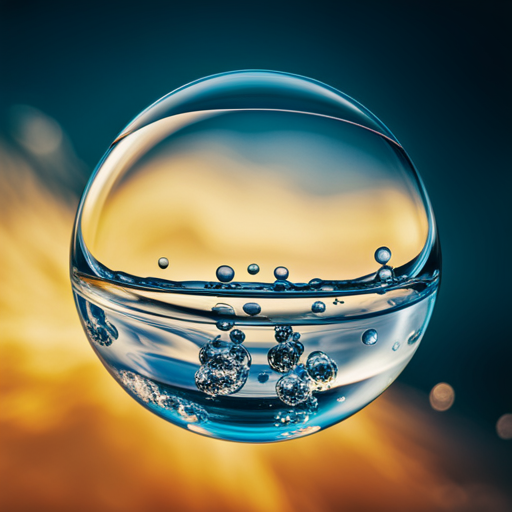Do you know what’s in your drinking water?
Bacterial contamination can pose a serious threat to your health, but fortunately, there are many methods for removing it from your water supply.
From agricultural runoff to septic systems, there are many sources of bacterial contamination that can affect your drinking water.
In this article, you will learn about the various methods for removing bacteria from drinking water, including filtration, chemical disinfection, and UV light disinfection.
You’ll also discover the importance of regular testing and treatment to ensure safe drinking water, and the different NSF standards applicable to removing bacteria from drinking water.
With this information, you can take the necessary steps to ensure clean water and happy health for you and your family.
Let’s dive in and explore how you can protect your health by removing bacteria from your drinking water.
Key Takeaways
– Bacteria in drinking water can cause illness and health issues, and common sources of contamination include agricultural runoff, septic systems, and surface water sources.
– Private well owners need to pay special attention to water quality and potential contamination, while public water supplies are regulated by the EPA and are required to be disinfected and tested regularly.
– Water filters with pore sizes smaller than 1 micron, ultrafiltration, nanofiltration, and chemical disinfection with chlorine or chloramine are effective ways to remove bacteria from drinking water.
– Third-party certification, such as NSF and ANSI, is important when installing treatment equipment to remove bacteria and other pathogens from your drinking water, and regular testing and treatment is necessary to ensure safe drinking water.
Sources of contamination
You already know that bacteria in drinking water can cause illness, but did you know that common sources of contamination include agricultural runoff, septic systems, and surface water sources?
Agricultural runoff occurs when rainwater or irrigation water carries excess nutrients and bacteria from farmland into nearby water sources. Septic systems can also leak bacteria into groundwater and surface water sources if not properly maintained. Surface water sources, such as lakes and rivers, can also be contaminated by animal waste and other pollutants.
Waterborne illnesses are a serious health risk associated with bacterial contamination in drinking water. Some of the most common bacteria and pathogens that can cause illness in humans include E. coli, Salmonella, and Hepatitis A.
Private well owners must pay special attention to water quality and potential contamination, as they are responsible for testing and maintaining their own water supply. Public water supplies are regulated by the EPA and are required to be disinfected and tested regularly, but tap water can still contain bacteria. Regular testing and treatment is necessary to ensure safe drinking water.
Treatment options
Consider using chemical disinfection, ultrafiltration, nanofiltration, or boiling as effective treatment options for eliminating harmful pathogens in your drinking water.
Chemical disinfection, such as chlorination or chloramine treatment, is a popular method for removing bacteria from drinking water. Chlorination involves adding chlorine to water to kill bacteria and viruses, but it can form disinfection byproducts that can be harmful to your health. Chloramine, on the other hand, is less corrosive and longer-lasting than chlorine, making it a safer and more effective option.
Ultrafiltration is another effective treatment option for removing bacteria from your water. This method uses a filter with pores smaller than 1 micron to remove bacteria and other pathogens. Ultrafiltration offers several advantages over chlorination, including better taste and odor, no disinfection byproducts, and no harmful chemicals. Additionally, ultrafiltration requires less maintenance than other treatment options, making it a cost-effective solution for clean drinking water.
Testing and certification
To ensure the effectiveness of your chosen treatment method, it is important to have your drinking water tested by a certified laboratory and to install treatment equipment that meets third-party certification standards such as NSF and ANSI. Third-party certification is important because it provides an independent evaluation of the product’s performance and safety. This certification is also necessary for many local and state regulations.
Testing frequency and procedures are also important for ensuring safe drinking water. Regular testing is necessary to identify any potential bacterial contamination and to ensure that treatment methods are working effectively. Testing procedures may vary depending on the type of treatment method being used, but it is important to follow the recommended guidelines for each method. Additionally, it is important to have any necessary maintenance and replacement of equipment done in a timely manner to ensure continued effectiveness. By following these guidelines and utilizing third-party certified equipment, you can ensure that your drinking water is safe and free of harmful bacteria.
| Testing Frequency | Testing Procedures | ||
|---|---|---|---|
| Annually | Total coliform and E. coli bacteria testing | ||
| Every 3-6 months | Testing for specific contaminants such as lead, nitrate, and arsenic | ||
| After any system changes or repairs | Retesting to ensure effectiveness of treatment method | ——————- | ——————– |
Conclusion
Congratulations! You’ve learned about the various sources of bacterial contamination in drinking water and the importance of removing bacteria to maintain good health.
You’ve also explored the different methods of removing bacteria from water, including filtration, chemical disinfection, and UV light disinfection.
Remember, regular testing and treatment are crucial to ensuring safe drinking water. Look for products that meet the appropriate NSF standards for removing bacteria from drinking water.
By taking these steps, you can have clean water and happy health for you and your family. Keep up the good work in maintaining a healthy lifestyle!




